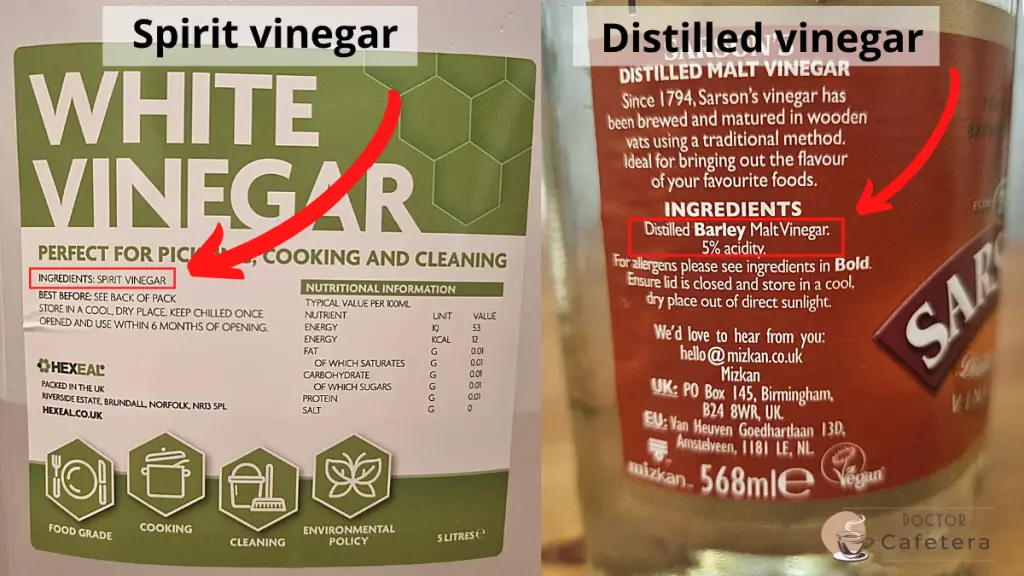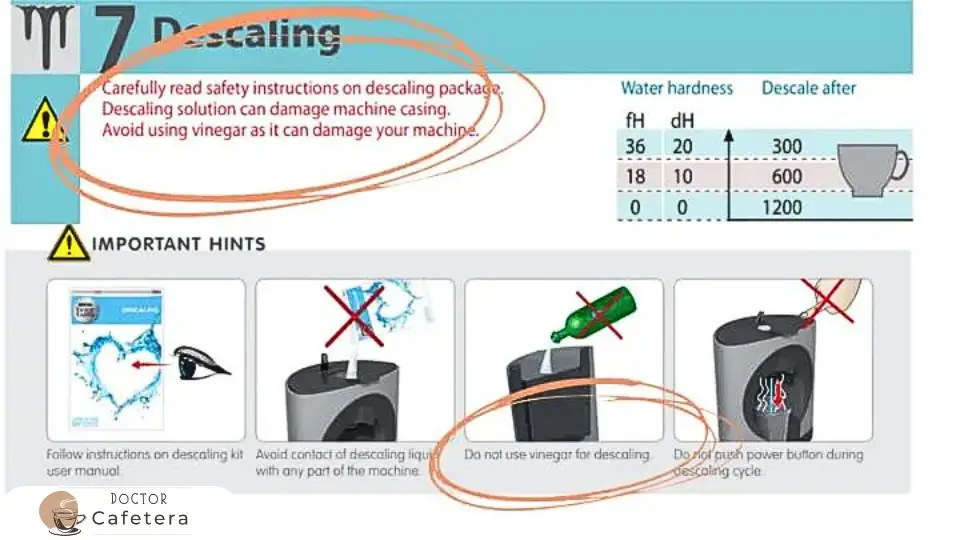If you have reached this article, it is most likely that your coffee maker has an orange light on, which means that in most brands and models, you should descale your coffee maker. Or it could also be that the coffee no longer comes out with the right pressure and your coffee maker needs an urgent descaling.
Once we are clear that we want to or should descale our coffee maker, the question arises as to whether we can use white vinegar or, on the contrary, we are obliged to use the descaling liquids recommended by the brand.
White vinegar has been used for many years to clean limescale deposits in household appliances and surfaces in contact with water. The anti-lime power of white vinegar lies in its high level of acetic acid, around 5%.
Types of white vinegar for descaling coffee machines
There is only one type of white vinegar, but it can be classified into two according to how it is extracted. Thus, white vinegar is called alcohol vinegar or distilled vinegar:
- One of the best-known names for white vinegar is spirit vinegar. It is usually obtained from sugar cane by allowing the sugar cane extract to undergo acid fermentation. During this process, the liquid is oxidized, and the chemical substances that compose it become more acidic, obtaining between 5% and 20% acetic acid.
- Another common name for white vinegar is distilled (malt vinegar), made from rice, malt, wine, fruit, etc. And as the name implies, it is distilled from ethanol. “Distilled” means that the liquid component is separated from the base mixture, producing a colorless solution with about 5% to 8% acetic acid in water.
Why use white vinegar to descale coffee makers?
In my experience and knowledge of domestic and commercial coffee, makers’ only reason not to use white vinegar for descaling is the objection of the brands in their instruction manuals.
If white vinegar has eliminated the limescale of those first drip coffee makers invented at the beginning of the 19th century or the espresso and Moka machines of the beginning of the 20th century, what makes today’s coffee makers different? Is there any particular component that vinegar affects negatively?
Using white vinegar to descale coffee makers makes even more sense considering the cost of descaling products. The difference in cost and performance is ten times greater in most commercial descalers. In addition, white vinegar (alcohol or malt vinegar) is obtained with more natural processes than commercial descalers, making them “greener” products.
Only if your coffee maker is high-end and very expensive, I recommend that you use the liquids recommended by the manufacturer, not because I think that white vinegar will damage your coffee maker, but because in case of a breakdown, they could justify it by having used vinegar and void the warranty. However, do not consider buying these commercial descalers if your coffee maker is in the medium-low range.
Why do the brands of coffee makers not recommend the use of vinegar for descaling?
It is curious how all the manufacturers that do not recommend using white vinegar to descale their coffee makers have chemical descaling products for sale. Here we can think in two ways; one well-intentioned and the other self-interested:
- As white vinegar harms their coffee makers, brands are forced to manufacture specific descalers for their coffee makers.
- The brands realize that their products are designed to last for years and that apart from regular coffee consumption, regular descaling is necessary to keep the machines in good condition. They create their own descaling solutions and make money from them.
In the image below, we see extracts from the manuals of Nespresso and Dolce Gusto coffee machines, where we are warned not to use white vinegar. However, none of these warnings are justified in an argumentative way. What components can be damaged? How does this damage occur? There is no argumentation because it does not exist!
Excerpts from the Dolce Gusto and Nespresso manuals about vinegar
When we disassemble a capsule coffee machine from any manufacturer, we always find the same components, made of the same materials; plastic water tank, aluminum thermoblock, plastic and stainless steel vibrating pump (internal parts), rubber pipes, and other metal components.
Even undiluted vinegar, with a standard 5% acetic acid percentage, could not damage these components by performing routine descaling and subsequent rinsing. At least, acetic acid is not much more corrosive than sulfamic acid in most commercial descalers.
How to use white vinegar to descale a coffee maker
Here I will show you how I like to use white vinegar to descale both the coffee pots I use and the ones I repair. Keep in mind that this method is based on my experience, so there is room for all the variations each user wants to add.
My method is based on the fact that the acetic acid in vinegar and the sulfamic acid in commercial descalers are equivalent. Although commercial descalers do not indicate the percentage of sulfamic acid they contain, in most of the bibliographies used for this article, 10% of this is recommended.
To be less aggressive with the amount of acid, I dissolve the vinegar in water at 50% so that I proceed to descale with 2.5% acetic acid, four times weaker than using a commercial descaler. There are occasions when I use pure vinegar (5%) for descaling, but only when the coffee maker is in very bad condition.
Note: Some coffee makers have a “descaling mode”. If your coffee maker has it, proceed with descaling using this mode, although it is not mandatory.
➡️ The Methodology:
- If the water tank has a filter, remove it before adding the vinegar and water mixture.
- Fill the water tank half with white vinegar and half with water.
- If your coffee maker has a descaling mode, proceed as indicated in the user’s manual.
- To descale a coffee maker without a descaling mode, proceed as you normally do to prepare a coffee, but in this case, without coffee, only with the mixture of vinegar and water in the tank. Wait between one operation and another for at least one minute.
- Rinse the tank very well and fill it with clean water.
- Pour water through the coffee maker, without coffee, to clean all the internal circuits.
Videos on how to descale different coffee makers with vinegar
Once you know the theory about descaling with vinegar, I will leave some explanatory videos on how to do it in different coffee makers, such as pods, drip, or espresso.
How to descale a coffee pod machine without “descaling mode”
This video shows how to descale a Keurig coffee pod machine using vinegar without a descaling mode:
How to descale a coffee pod machine with “descaling mode”
This video shows how to descale a Keurig coffee pod machine using vinegar with a descaling mode:
How to descale an espresso machine with descaling mode
This video shows how to descale an espresso machine with “descale mode”. Specifically, the example is the Breville Barista Express:
How to descale a superautomatic coffee machine
This video shows how to descale a superautomatic coffee machine with or without descaling mode.

